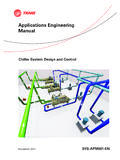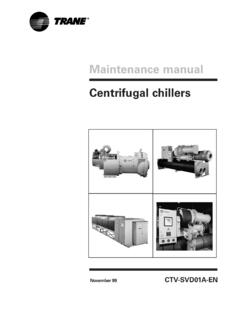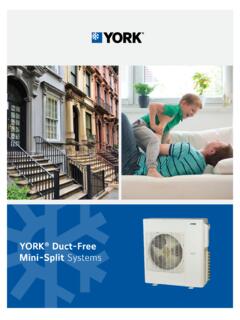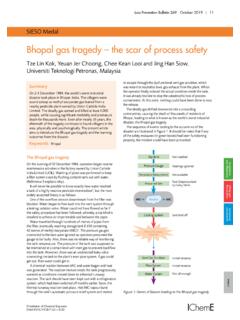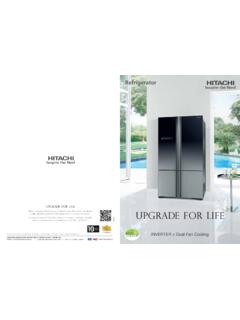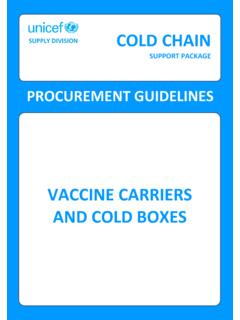Transcription of Chilled-Water Systems One of the Systems Series / Air ...
1 August 2012 TRG-TRC016-ENAir Conditioning ClinicChilled-Water SystemsOne of the Systems SeriesChilled-Water SystemsOne of the Systems SeriesA publication of TranePreface 2001 Trane All rights reservedTRG-TRC016-ENiiTrane believes that it is incumbent on manufacturers to serve the industry by regularly disseminating information gathered through laboratory research, testing programs, and field Trane Air Conditioning Clinic Series is one means of knowledge sharing. It is intended to acquaint a nontechnical audience with various fundamental aspects of heating, ventilating, and air conditioning. We have taken special care to make the clinic as uncommercial and straightforward as possible. Illustrations of Trane products only appear in cases where they help convey the message contained in the accompanying particular clinic introduces the reader to Chilled-Water Trane Air Conditioning ClinicChilled-Water SystemsFigure 1 TRG-TRC016-ENiiiContentsperiod oneTypes of Water Chillers.
2 1 Vapor-Compression Water Chillers .. 3 Air-Cooled or Water-Cooled Condensing .. 6 Packaged or Split Components .. 11 Absorption Water Chillers .. 15 Equipment Rating Standards .. 18period twoChilled-Water System Design .. 26 Load-Terminal Control .. 28 Parallel Configuration .. 35 Series Configuration .. 38 Primary-Secondary System Operation .. 53period threeSystem Variations .. 59 Alternate Fuel Choice .. 59 Low-Flow Systems .. 61 Variable-Primary-Flow Systems .. 64 Preferential Loading .. 66 Heat Recovery .. 68 Asymmetric Design .. 72 Free Cooling .. 75 Application Outside the Operating Range of the Chiller .. 78period fourChiller-Plant Control .. 79 Chiller Sequencing .. 82 Failure Recovery and Contingency Planning .. 90 System Tuning .. 92 System Optimization .. 96 Operator Interface .. 100period fiveReview .. 103 Quiz .. 108 Answers .. 110 Glossary .. 112ivTRG-TRC016-ENTRG-TRC016-EN1notesper iod oneTypes of Water ChillersWater chillers are used in a variety of air conditioning and process cooling applications.
3 They cool water that is subsequently transported by pumps and pipes. The water passes through the tubes of coils to cool air in an air conditioning system, or it can provide cooling for a manufacturing or industrial process. Systems that employ water chillers are commonly called Chilled-Water designing a Chilled-Water system, one of the first issues that must be addressed is to determine which type of water chiller to use. This period discusses the primary differences in chiller refrigeration cycle is a key differentiating characteristic between chiller types. The vapor-compression and absorption refrigeration cycles are the two most common cycles used in commercial air oneTypes of Water ChillersChilled-Water SystemsFigure 2absorptionwater chillercentrifugalwater chillerFigure 32 TRG-TRC016-ENnotesperiod oneTypes of Water ChillersWater chillers using the vapor-compression refrigeration cycle vary by the type of compressor used. Reciprocating, scroll, helical-rotary, and centrifugal compressors are common types of compressors used in vapor-compression water water chillers make use of the absorption refrigeration water chillers use a compressor to move refrigerant around the system.
4 The most common energy source to drive the compressor is an electric motor. Absorption water chillers use heat to drive the refrigeration cycle. They do not have a mechanical compressor involved in the refrigeration cycle. Steam, hot water, or the burning of oil or natural gas are the most common energy sources for these types of Sourcesheat-drivencompressor-drivenFigur e 4 TRG-TRC016-EN3period oneTypes of Water ChillersnotesVapor-Compression Water ChillersIn the vapor-compression refrigeration cycle, refrigerant enters the evaporator in the form of a cool, low-pressure mixture of liquid and vapor (A). Heat is transferred from the relatively-warm air or water to the refrigerant, causing the liquid refrigerant to boil. The resulting vapor (B) is then drawn from the evaporator by the compressor, which increases the pressure and temperature of the refrigerant hot, high-pressure refrigerant vapor (C) leaving the compressor enters the condenser, where heat is transferred to ambient air or water at a lower temperature.
5 Inside the condenser, the refrigerant vapor condenses into a liquid. This liquid refrigerant (D) then flows to the expansion device, which creates a pressure drop that reduces the pressure of the refrigerant to that of the evaporator. At this low pressure, a small portion of the refrigerant boils (or flashes), cooling the remaining liquid refrigerant to the desired evaporator temperature. The cool mixture of liquid and vapor refrigerant (A) travels to the evaporator to repeat the vapor-compression refrigeration cycle is reviewed in detail in the Refrigeration Cycle Air Conditioning Cyclecompressorcompressorexpansionexpans iondevicedeviceenergy inenergy inabsorb heatabsorb heatreject heatreject heatevaporatorevaporatorcondensercondens erABCDF igure 54 TRG-TRC016-ENnotesperiod oneTypes of Water ChillersThe type of compressor used generally has the greatest impact on the efficiency and reliability of a vapor-compression water chiller. The improvement of compressor designs and the development of new compressor technologies have led to more-efficient and -reliable water reciprocating compressor was the workhorse of the small chiller market for many years.
6 It was typically available in capacities up to 100 tons [350 kW]. Multiple compressors were often installed in a single chiller to provide chiller capacities of up to 200 tons [700 kW].Scroll compressors have emerged as a popular alternative to reciprocating compressors, and are generally available in hermetic configurations in capacities up to 15 tons [53 kW] for use in water chillers. As with reciprocating compressors, multiple scroll compressors are often used in a single chiller to meet larger capacities. In general, scroll compressors are 10 to 15 percent more efficient than reciprocating compressors and have proven to be very reliable, primarily because they have approximately 60 percent fewer moving parts than reciprocating compressors. Reciprocating and scroll compressors are typically used in smaller water chillers, those less than 200 tons [700 kW]. Helical-rotary (or screw) compressors have been used for many years in air compression and low-temperature-refrigeration applications.
7 They are now widely used in medium-sized water chillers, 50 to 500 tons [175 to 1,750 kW]. Like the scroll compressor, helical-rotary compressors have a reliability advantage due to fewer moving parts, as well as better efficiency than reciprocating compressors have long been used in larger water chillers. High efficiency, superior reliability, reduced sound levels, and relatively low cost have contributed to the popularity of the centrifugal chiller. Centrifugal compressors are generally available in prefabricated chillers from 100 to 3,000 tons [350 to 10,500 kW], and up to 8,500 tons [30,000 kW] as built-up TypesFigure 6 TRG-TRC016-EN5period oneTypes of Water ChillersnotesThese various types of compressors are discussed in detail in the Refrigeration Compressors Air Conditioning capacity of a centrifugal chiller can be modulated using inlet guide vanes (IGV) or a combination of IGV and a variable-speed drive (adjustable-frequency drive, AFD). Variable-speed drives are widely used with fans and pumps, and as a result of the advancement of microprocessor-based controls for chillers, they are now being applied to centrifugal water an AFD with a centrifugal chiller will degrade the chiller s full-load efficiency.
8 This can cause an increase in electricity demand or real-time pricing charges. At the time of peak cooling, such charges can be ten (or more) times the non-peak charges. Alternatively, an AFD can offer energy savings by reducing motor speed at low-load conditions, when cooler condenser water is available. An AFD also controls the inrush current at system characteristics favor the application of an adjustable-frequency drive, including: A substantial number of part-load operating hours The availability of cooler condenser water Chilled-Water reset controlChiller savings using condenser- and Chilled-Water -temperature reset, however, should be balanced against the increase in pumping and cooling-tower energy. This is discussed in Period Four. Performing a comprehensive energy analysis is the best method of determining whether an adjustable-frequency drive is desirable. It is important to use actual utility costs, not a combined cost, for demand and consumption on the application, it may make sense to use the additional money that would be needed to purchase an AFD to purchase a more efficient chiller instead.
9 This is especially true if demand charges are Drivesvariablevariable--speedspeeddrived riveFigure 76 TRG-TRC016-ENnotesperiod oneTypes of Water ChillersAir-Cooled or Water-Cooled CondensingThe heat exchangers in the water chiller (the condenser and evaporator) have the second greatest impact on chiller efficiency and cost. One of the most distinctive differences in chiller heat exchangers continues to be the type of condenser selected air-cooled versus comparing air-cooled and water-cooled chillers, available capacity is the first distinguishing characteristic. Air-cooled chillers are typically available in packaged chillers ranging from to 500 tons [25 to 1,580 kW]. Packaged water-cooled chillers are typically available from 10 to 3,000 tons [35 to 10,500 kW]. Condenser Typeswater-cooledair-cooledFigure 8 Air-Cooled or Water-Cooled0 tons0 tons[0 kW][0 kW]1,000 tons1,000 tons[3,517 kW][3,517 kW]2,000 tons2,000 tons[7,034 kW][7,034 kW]chiller capacitychiller capacitywaterwater--cooledcooledairair-- cooledcooled1,500 tons1,500 tons[5,276 kW][5,276 kW]2,500 tons2,500 tons[8,793 kW][8,793 kW]500 tons500 tons[1,759 kW][1,759 kW]3,000 tons3,000 tons[10,551 kW][10,551 kW]Figure 9 TRG-TRC016-EN7period oneTypes of Water ChillersnotesA major advantage of using an air-cooled chiller is the elimination of the cooling tower.
10 This eliminates the concerns and maintenance requirements associated with water treatment, chiller condenser-tube cleaning, tower mechanical maintenance, freeze protection, and the availability and quality of makeup water. This reduced maintenance requirement is particularly attractive to building owners because it can substantially reduce operating that use an open cooling tower must have a water treatment program. Lack of tower-water treatment results in contaminants such as bacteria and algae. Fouled or corroded tubes can reduce chiller efficiency and lead to premature equipment or water-cooledMaintenance Water treatment Condenser tube brushing Tower maintenance Freeze protection Makeup watercooling towercooling towerFigure 108 TRG-TRC016-ENnotesperiod oneTypes of Water ChillersAir-cooled chillers are often selected for use in Systems that require year-round cooling requirements that cannot be met with an airside economizer. Air-cooled condensers have the ability to operate in below-freezing weather, and can do so without the problems associated with operating the cooling tower in these conditions.



